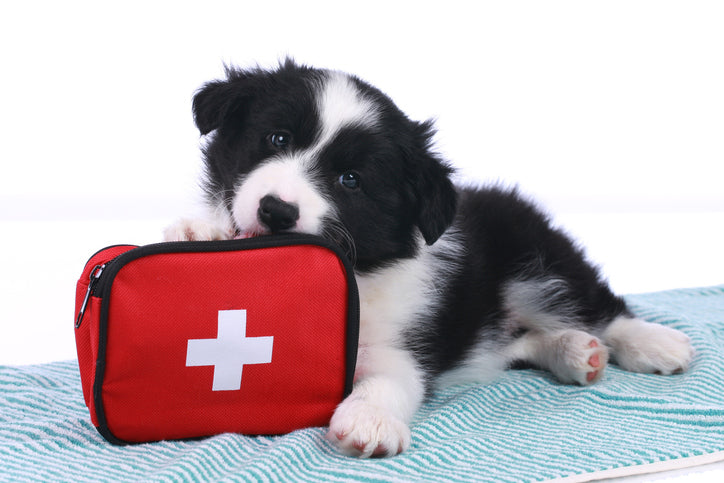It is November and with it comes the time of year when many of us are busy with the hustle, bustle, and preparations for the upcoming holidays. November is also Epilepsy Awareness Month, a time to support those living with epilepsy—humans and canines.
So while you are making lists and checking them twice, I encourage you to do a purple awareness ribbon in support, and if you share your life with a dog who has Canine Epilepsy, to use this time to take inventory of your dog’s Epi First Aid Kit.
First, and foremost, if your dog has a seizure, be sure to take steps to keep them safe, away from other pets, made as comfortable as possible, and contact your vet or emergency veterinarian hospital immediately. Being in touch with your dog’s vet is a must and critical to the health of your dog.
As part of my FiveSibes #LiveGibStrong K-9 Epilepsy Awareness Campaign, I share tips and important information to help educate families who live with, or who are adopting, a dog that has seizures. One of the things I kept handy and highly recommend to Epi-dog caregivers is to have an up-to-date Epi First Aid Kit.
What is an Epi First Aid Kit?
An Epi First Aid Kit is a standard canine First Aid Kit that also includes essential items needed for the care of an Epi-dog.
What can I use to hold the First Aid Kit items?
Any type of container that will hold the items will do. It should be obviously labeled and easily recognized, such as a red duffel bag with compartments, or a large basket or container marked “First Aid Kit.” Keep the First Aid Kit in a place where all members of the family can locate it during an emergency.
What should be in my dog’s Epi First Aid Kit?
In addition to the standard items in your pet’s First Aid Kit, I recommend these additional items for Epi-dogs:
- Prescribed anti-seizure medications, or a note as to where they are located.
- Instructions for administering meds, dosages, and seizure protocol for family members and pet sitters caring for your dog in your absence.
- Emergency phone numbers of vet, neurologist, emergency vet hospital, a family member or friend to assist if needed, etc.
- Copy of your Epi-dog’s vet records (in case you are away with your dog or wind up at the emergency hospital).
- Instant cool packs to help cool down the seizing dog as his/her body temperature can rise dangerously during a seizure (a baggie with crushed ice or frozen peas/veggies can also be used).
- Thermometer to monitor the dog’s temperature post-seizure.
- Alcohol swabs* (see caution note below).
- Journal** – with description of seizure, time, and length of seizures, as well as medication times and what your do was doing prior to the seizure. This information you will then share with your vet.
- Pet towel (to wet and lay over dog to cool down).
- Hand-held fan.
- Rescue Remedy®
For Post-Seizure Care & Clean Up:
- Pet wipes
- Disinfectant wipes
- Paper towels
- Disposable latex or non-latex gloves
- Disposable bags
Additional Items to Have on Hand
- Natural vanilla ice cream (to help raise sugar levels post-seizure).
- Corn syrup, honey, or maple syrup (if ice cream is not available or dog cannot eat dairy).
- A source of protein, such as low-fat cheese sticks, natural creamy peanut butter, chicken, tuna, plain yogurt, cottage cheese, etc. (to give to dog post-seizure after ice cream or syrup to help stabilize sugar levels).
- Fresh water (allow dog to take sips post-seizure).
- A cooler collar (kept in freezer).
- A cooler water bed or mat for dog to lay on to help lower temperature.
- Ramp or large sheet/blanket (to transport dog).
*Alcohol swabs should only be used in extreme emergencies, where no cool or ice packs are available. A light wipe to the paw pads or tips of ears can help an overheating dog cool down, however, alcohol can cause seizures itself in some dogs if it is licked or absorbed. Unless under veterinarian care, I highly recommend using instant cool packs, gel ice packs, or crushed ice in a baggie to cool down a seizing dog. (If your Epi-dog has short or shaved fur, or is a single-coated dog, wrap ice pack in a cloth).
**A journal can be a notebook or chart with handwritten information, or it can be a digital application. An excellent digital journal is the free Royal Veterinary College’s Pet Epilepsy Tracker app available for Apple and Android devices (through iTunes Store or Google Play).
Notation: Always check the expiration dates on medications, supplements, and other items in your Epi First Aid Kit to be sure they are not outdated, and update the items accordingly.
Whether your dog has epilepsy, or not, s/he may have special needs or items that should be included in the First Aid Kit in case of emergency, so please take this month to make a point to discuss and review your list of items, as well as the appropriate applications, with your dog’s veterinarian.
 Dorothy Wills-Raftery
Dorothy Wills-Raftery
Dorothy Wills-Raftery is an award-winning photojournalist and author of EPIc Dog Tales: Heartfelt Stories About Amazing Dogs Living & Loving Life With Canine Epilepsy; the FiveSibes™ Tales children’s books What’s Wrong With Gibson? Learning About K-9 Epilepsy and Getting Healthy With Harley: Learning About Health & Fitness; and Buddy, the Christmas Husky~Based On A True Holiday Miracle books (ArcticHouse Publishing), as well as the international FiveSibes blog, based on the lives of her five Siberian Huskies. Her work has also appeared in American Pet Magazine, Ruff Drafts, The Sled Dogger, and Hudson Valley Paw Print Magazine. Dorothy is the writer and host of “The Sibe Vibe” Dog Works Radio show.” Named “Best Author” in 2015 & 2016 by Hudson Valley Magazine and all four books named “Best in Print” by American Pet Magazine, Dorothy is a 5-time Dog Writers of America Association “Excellence” nominee, winning the prestigious Maxwell Medallion in 2016 for her writing. An official International Purple Day® for Epilepsy Ambassador since 2012 and a volunteer case manager for The Wally Foundation-Canine Epilepsy, Dorothy is the creator of the FiveSibes #LiveGibStrong K-9 Epilepsy Awareness campaign inspired by her own epileptic Husky, Gibson. In addition to her Siberian Huskies, Dorothy shares her home with her husband, daughter, son-in-law, and new grandson. You can follow Dorothy and her FiveSibes on Facebook at FiveSibes: Siberian Husky K9 News & Reviews, on Google + , Twitter, and Instagram (@FiveSibesMom).




 Dorothy Wills-Raftery
Dorothy Wills-Raftery


